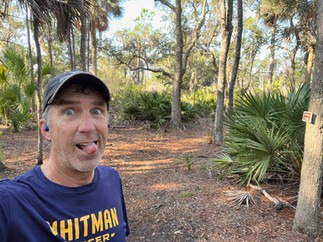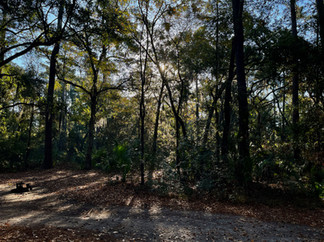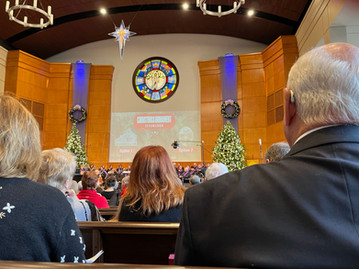(SC & GA) - The South is stunning . . . in so many ways.
- randyjoss
- Jan 6, 2023
- 15 min read

Maybe it's because we "started" in Wilmington, home of a race-based Coup d'Etat. Or maybe it was just coincidence. Whatever the reason, the last 2 weeks before Christmas break were some of the most mind-blowing of the trip. These two clippings seemed to capture the range of emotions we felt.
The left hand image is a sign posted outside a restaurant in Charleston, SC. Hyman's Seafood restaurant was started as a wholesale business in 1890 by a Jewish immigrant from eastern Europe and it is now being run by its FIFTH generation of the same family. They are very definitely "Southern" and the restaurant felt like the perfect introduction to Southern Culture. In addition to the fantastic food (I love shrimp and grits), we felt like the hospitality, politeness, and devotion to service evidenced by this sign was present in every employee we encountered. We even got to meet Viktor (the current generation of Hyman management) and the way he hustled around the restaurant adjusting plates, meeting customers, and coaching employees was awe inspiring. Though we are complete novices when it comes to the South, this restaurant and its sign seemed to be an example of the best of Southern Culture.
The right hand image above is a clipping from the Atlanta Constitution (Nov 28, 1915) regarding a ceremony that took place on top of Stone Mountain. Inspired by D.W. Griffith's 1915 movie The Birth of a Nation, locals resurrected and re-energized the Ku Klux Klan (the so-called "Second Klan"). In the newspaper, the meeting is treated like a high class social event. And we assume that "most interesting" rites referred to in the last line refers to the cross burning on top of the mountain.
We'd heard the phrase Stone Mountain before (it's referenced in MLK's I have a dream speech), but never knew much about it. At my cousin Jane's suggestion, we visited the park (It's part of the Georgia State Park system) and were stunned to find Jefferson Davis, Robert E Lee, and Stonewall Jackson carved into this enormous mountain (larger than Rushmore) at the center of an attraction that's part theme park and part church of the Lost Cause of the Confederacy. (More on the "Lost Cause" mythology below but the Wikipedia overview is here)

Like most west-coasters, we've spent lots of time discussing micro-aggressions in the past 10 years, but perhaps Stone Mountain qualifies as a MACRO-aggression? No mention was made of slavery, lynchings, or white supremacy. The larger context of the Civil War and the any opinion that the non-white population might have had of the war was left out. This was our first, real introduction to the Lost Cause version of Civil War history and it was a stunning reminder of the darker side of Southern Culture.
More on all this below in the thought for the day. In the meantime, it's helpful to see what preceded Stone Mountain for us.
During the two weeks after Thanksgiving we made our way from Charleston, SC all the way down to Jacksonville, FL (because we missed out turn off!) and then back up to Atlanta.
Highlights included:
Charleston, SC - Our first guided tour of a city, plus the wonderful Charleston Christmas parade, complete with police drill team and a float for "Miss Plus-Size Charleston" . . . and a full gospel choir.
Savannah & Pin Point, GA - Here we got a two guided tours of the city, but this time from the African American perspective on the town.
The Okefenokee Swamp - Where we stayed at an RV resort owned by a San Diego guy, but got a deep introduction to small town Southern life.
Augusta, GA - We got to visit Randy's cousin Jane & her husband Roger who have recently moved here from upstate NY where they lived near the farm in Putnam
Stone Mountain, GA - As I said above, this was our formal introduction to the Lost Cause propaganda and it's hold on Southern Culture.
Charleston, SC
Ok, we started slowly in the South. A history and architecture tour with a white, local professor (Dr. Eric Lager from the Citadel). The buildings, trees, ironwork and cobblestone streets are beautiful -- especially when dressed up for Christmas. Oh, and the Sunday breakfast at local chain Big Bad Breakfast is pretty great too. (though Southerners are missing out on real maple syrup!)
The most interesting part of Charleston though was the Christmas parade and celebration. The police motorcycle drillteam was loud and intimidating. The floats and dance troups were exhilarating. And the crowd was both huge and enthusiastically multi-racial. It turns out that there are almost twice as many churches per capita in the South than in the far West, yet far fewer different types of churches. It's largely Protestant and Catholic, and Christmas is THE big deal. The Christmas parade ended at a park downtown and rolled right into a great concert by a local gospel choir (the Low Country Voices) and televised tree lighting. As evidence by the dancing and singing, everyone was really into it. The Charleston mayor turns out to have a degree in jazz from the Berklee College of Music. He joined the choir on a few numbers and plays a mean piano! Afterwards we had our first taste of BBQ -- Carolina Style, which I think means with a mustard based sauce -- at Lewis BBQ in the north part of town. The pulled pork was pretty good, but the ribs were the star of the show!
A little taste of the Low Country Voices . . .
Savannah, GA
In Savannah we started to dig a little deeper, lining up Dr. Jamal Toure (who teaches at Georgia Southern) to give us a Gullah-Geechee focused tour of the city. The Gullah Geechee people are descendants of Africans who were enslaved on the rice, indigo and Sea Island cotton plantations of the lower Atlantic coast. Many were from rice growing regions of West Africa and so were thought to be a good fit with the agriculture and weather of the SE coast. They developed their own creole language and culture, unique to the region.
Pin Point, SC -- Crabs, Oysters, & Clarence Thomas
While we were in Savannah we stayed at a local state park -- Skidaway State Park -- just outside of town. It is a magical place, with oaks dripping with moss right on the edge of the swamp land. The park also featured running and walking paths through the forest and swampland so we could both get a little exercise. We liked it so much that we even decided to stay an extra night.
On the way there however, we stumbled on the community Pin Point which turned out to have a really amazing museum and an incredible and complicated history. For nearly 100 years, Pin Point was isolated and self sustaining, a poor, Gullah-Geechee community founded by first generation freedmen fishermen. In the early part of the 20th century a white man named Algernon Varn "bought" the land around Pin Point from a local Gullah man named James Street when Street defaulted on a loan Varn had extended to him for a new outboard motor. Instead of repayment, Varn got title to Street's land in the Pin Point area.
While the fairness of that deal seems debatable, it's clear that "Old Man Varn", who had been a Savannah wholesale dealer for years, was not your typical plantation owner. Unusually for those times, Mr. Varn moved his home out to Pin Point and put down deep roots in community. The A.C. Varn & Sons oyster & crab business he started eventually employed most of the local men and women. The isolated and tight knit community thrived on the kindness and hard, hard work of all involved -- both black and white -- and they all gathered together at the Hinder Me Not Baptist church. Old Man Varn seems to have been a quirky fellow with a bad stutter who "poured his soul" into everything he did, including babysitting workers' kids, helping workers get their driver's licenses, and funding their pride & joy, the Pin Point Rams softball team. From the museum info and the interviews we watched & read, it seems like Old Man Varn was widely loved.
Pin Point is also the birthplace of Clarence Thomas. There's a terrific, 30 minute YouTube about the history of Pin Point with interviews of a many locals, including Justice Thomas. They talk about what it was like to grow up there and what the community meant to them. It's a side of a sitting justice that you very rarely get to see.
We were struck by the sudden thought that having a supreme court justice with these difficult life experiences is usually exactly what we would want for the highest court in the land.
Here's the video. See if you can pick out the supreme court justice!
The A.C. Varn oyster & crab business closed for good in 1985. It seems it was killed by a number of factors, some of which sound like familiar boogeymen to us -- pesticides, overfishing, and road construction that wreaked havoc on the marine life -- as well as others like the establishment of the minimum wage and agricultural inspections, government policies that were well-intentioned but ultimately mortal wounds for this small business.
It makes us wonder how that stew of government actions and inactions played out in the mind of a young Clarence Thomas. . . . It's not hard to imagine it creating a profound skepticism of ANY government action.
Folkston, GA
From Savannah we drove south to the Okefenokee swamp. Well, actually, we missed our exit and ended up in Jacksonville Florida for a moment before we circled back to the swamp. Folkston is essentially the eastern gateway to the Okefenokee Wildlife Refuge, and possibly our gateway to small town southern life. Here are a few facts. In round numbers:
Race: 45% black, 35% white, and 10% hispanic.
Poverty: almost 40% live below the official poverty line. (vs. 12% nationwide)
Race & Poverty: 43% poverty for blacks & 37% for whites
Median HOUSEHOLD Income: $25,000 (vs. ~$70,000 nationwide)
Unemployment: ~30% (vs. 3% nationwide)
As in the Ohio River Valley, it's really not surprising that a town like this wants for America to be "Great Again" . . . because things are really NOT great right now. In the Folkston area, Herschel Walker beat Raphael Warnock by over 50 percentage points!
Our impressions of Folkston though ALSO included some of the best BBQ we've tried so far, at Dap's BBQ (which is a tiny shack at the side of the road), the many examples of racial integration at the businesses & neighborhoods we visited, and a vibrant little downtown including restaurants, a grocery store, a Walgreens, and a hardware store. Folkston's popup Christmas market downtown was a sweet and uplifting collection of food and Christmas products from a wide variety of multi-racial merchants all happily engaged in non-transactional conversations with their many customers. It's fair to say that life in Folkston is challenging, but nothing is ever quite what it seems when you first look at the numbers.
Before you move on though you need to take a moment to appreciate the, uh, uniqueness of Dap's BBQ. BY FAR, the most popular thing on the menu is the "parfait" (pictured below). It's a whole pulled pork dinner in a cup, including the mash potatoes, gravy, pork, and if I'm not mistaken, even the banana pudding!
The Okefenokee Swamp National Wildlife Refuge
This was a total accident of a find. We were just scanning the map of Georgia and thinking, "Hmmm. Where should we go?" when we noticed this giant green area in the south of the state. The swamp has been around for ages and has survived humankind's best attempts to "drain the swamp". It is a fascinating place and if you're curious, you can rent a canoe and "backpack" to a wide variety of camping "platforms" throughout the park. Given all the gators we saw on our swamp tour, we decided we'd pass on the whole "camping in the swamp" experience!
We would be remiss if we didn't mention how much we liked the Okefenokee Pastimes RV park/resort that we stayed in. Dustin runs a construction company in San Diego, but he and his father found this little business and bought it a few years ago. It's clean, has terrific service, is across the street from the park, AND he mixes a great drink. Randy was also able to get in a nice run on the local dirt roads where he met a vicious looking (but actually very sweet) dog who insisted on following him for about a mile. :-)
Augusta, GA
After our long visit to Putnam in September, we really needed to visit Randy's cousin (actually 1st cousin, once removed if you want to be technical about it) in Augusta. Jane grew up on and around the farm in Putnam, but she and her husband Roger have recently moved them from NY to GA to be closer to her daughter's family (and warmer weather) in Augusta. They say they are still adjusting to their new lives, but to us they seemed very much at home. We had a terrific couple days in Augusta with great conversations and lots of laughs.
Our visit started with Sunday services at their newly adopted church. Jane is in the bell choir and was laser-focused and error free in a terrific performance. Dinner with Jennie (technically Randy's 2nd cousin), her husband Greg, and daughter Kelly was a great highlight, especially when Roger consented to modelling a few of his many pieces of Elvis-themed clothing! (He's a huge fan)
The next day we explored around Augusta and walked over our first memorial to the Confederacy -- the newly renovated Jefferson Davis bridge. It has recently been remodeled as a pedestrian bridge (which, ironically, leads to nowhere as it's closed by a fence on the other side). During the remodel, the Jefferson Davis plaques and monuments were removed and refurbished and then reinstalled. Although the city "renamed" the structure Freedom Bridge they are not legally allowed to remove the monuments. It was the first time that we realized how tightly the Lost Cause version of history is still held by many folks in the South. (Here's an Atlantic article with a bit of background). To them, the war is still a sore point, Robert E. Lee is a demi-god, and the fuss about slavery was way overblown.
It turns out that if you don't understand the history and meaning of the Lost Cause mythology, there's no way to fully understand the South.
In talking about our impressions, thoughts, and feelings about the bridge, it was Jane that suggested we visit Stone Mountain on our way to the Atlanta Airport.
Stone Mountain, GA
So we finally arrived in Stone Mountain. I suppose I should set the scene more clearly. So here's the condensed background.
"The Lost Cause is an interpretation of the American Civil War (1861–1865) that seeks to present the war, from the perspective of Confederates, in the best possible terms. Developed by white Southerners, many of them former Confederate generals, in a postwar climate of economic, racial, and social uncertainty, the Lost Cause created and romanticized the “Old South” and the Confederate war effort, often distorting history in the process."
According to them, there are 5 tenets of this interpretation (edited for succinctness):
States rights, not slavery was cause of the war
African Americans were "faithful slaves", loyal to their masters, happy in their lives, and unprepared for freedom
The Confederacy lost only because of the Union's overwhelming superiority of resources
"Confederate soldiers were heroic and saintly", especially Robert E. Lee who is revered as the pre-eminent example of Southern manhood.
Southern women were loyal and devoted supporters of the war and "willingly sacrificed their husbands, fathers, sons and neighbors for the cause."
The Civil War seems to be a never ending inspiration for interesting and thought provoking historical research and opinion. In particular, we were interested to read pieces from such disparate sources as the Atlantic and Forbes about the question of whether the war was even necessary. (spoiler alert: they come to slightly different conclusions) However, the stand alone, white supremacist war monuments were something that we naively expected to see fading away. In other words, in this day and age, doesn't everyone understand that history is not complete until we can see an event from multiple points of view? Isn't the narrow viewpoint of just one section of society more propaganda than history?
By this token, the Lost Cause view is certainly propaganda. As a counterpoint though, Randy's cousin Jane gave us a copy of "Robert E. Lee and Me: A Southerner's Reckoning with the Myth of the Lost Cause" written by the brigadier general and West Point history professor Ty Seidule . In it, he describes his upbringing in the South and the many places where the stories, myths, and norms he learned growing up can be expanded and improved upon by the history he's learned as an adult. It's a terrific read that goes quickly, but which is especially not kind to General Lee.
With this as background, we stumbled onto Stone Mountain. Here are the bullet points in the order they hit us.
It's a 900 ft high piece of granite glorifying Jefferson Davis, Robert E. Lee, and Stonewall Jackson. And their favorite horses.
It's larger than Mt. Rushmore and was begun by the same sculptor, who turns out to have been a Klan member
In 1915, the owner of the property, Samuel Venable, hosted a Klan meeting at the top of the hill (the one referred to in the article pictured up top) which began the second incarnation of the Klan in the South. And, in 1923 he granted them the right to hold meetings on the property in perpetuity.
At the base of the mountain is a small lake and a gigantic amphitheater. The effect for us was of a large church, complete with pews, baptismal font, and altar. . . with Robert E. Lee on the altar instead of a cross.
Surrounding the amphitheater is a path on which are monuments to all the Confederate states, complete with flagpoles flying each state's Confederate flag.
Around that is, oddly, an amusement park complete with picnic grounds, kids' play area, and a tram to the top of the mountain.
In front of the park flies a giant U.S. flag.
Here's an old flyer for the mountain, from the early 20th century.
flyer courtesy of the Southern Poverty Law Center site (https://www.splcenter.org/fighting-hate/intelligence-report/2018/stone-mountain-monumental-dilemma)
For us the moment was, well, profoundly disorienting. Perhaps no greater motivation for the study of history has ever been created.
In the words of Gen Z, this was a "Wait. What??" moment.
Especially recently, there has been talk that Stone Mountain should be "taken down" or that the park should be expanded to cover multiple viewpoints of the Confederacy. Relative to the long history of the site, this discussion seems to be in its infancy. And from what we could understand about politics in Georgia, it seems unlikely to be successful anytime soon.
Here are a couple more pictures of the site as well as images of a few of the more interesting t-shirt designs in the gift shop. The particularly strong tie between Christianity and the Confederacy was yet another amazing, confusing part of Stone Mountain
Thought for the day: History vs. Propaganda?
Stone Mountain was perhaps the most confusing, fascinating, and motivating place we've visited in the last 6 months. Confusing, because we naively had NO idea that such a place still existed. Fascinating because it's not just a one off, tiny museum in a corner of the state. It's a major state park that welcomes 4 million visitors a year through its gates. And it's certainly motivated us to read more, visit more, and engage in more conversation.
Seeing hatred & kindness side by side, co-existing in Southern Culture, has only made us want to learn more.
We aren't historians and certainly can't add much substance to the debate over something like critical race theory, but I think even high schoolers can agree it doesn't make sense to leave half the society out of the historical record. To be honest, neither of us leans towards the removal of Stone Mountain. But, what would it feel like if it honored and elevated more points of view? For example:
How do members of the armed forces think about Lee's actions? Did he violate his oath as an officer?
What is the African American perspective on the the Lost Cause ideals elevated by the carving?
Could Stone Mountain occupy a spot, maybe an important spot, on the US Civil Rights Trail?
Why not make the KKK history at Stone Mountain explicit instead of unspoken? What if all visitors could read and debate about the role the Klan has played in defining "Southern Culture"?
Or maybe it could even address the question of how to take pride in being "Southern" while simultaneously condemning slavery and opposing discrimination?
Would Stone Mountain be diminished or strengthened by the inclusion of a broader set voices? To us it would inestimably more valuable.
Admittedly, we're just west coasters, so what do we know. However, this is not just a challenge for the South. All our own communities could find similarly slanted or neglected histories in our own backyards. Whether it's Native Americans & the mission system, Latino farmworkers and UFW, or inner city African Americans & the LA police, California undoubtedly has many sites where our historical record falls short of complete . . . or just.
In our travels we've been lucky to find a few locations that actually ask these questions well (Monticello's treatment of Sally Hemings or the Women's Rights Museum's treatment of Native Americans are two that spring to mind), but they're in the minority.
There is much to enjoy and to admire about the culture of the South. Hospitality, food, community spirit, kindness, and a willingness to just stop and chat and see you as a person. It's a way of life that seems to value humanity more than objects, and relationships over transactions. These are qualities we've grown to love in the towns we've visited, and would appreciate seeing more of in our own communities. However, the glorification of the "Lost Cause", the deification of General Lee, and the exclusion of the Black perspective on the war and slavery is much, much more problematic. As we continue our journey, exploring the US Civil Rights trail monuments across the Deep South, I expect we'll get a much clearer understanding of just how close to the present those problems are.
Joan & I entered into this adventure wondering if the U.S. treatment of slavery would have some parallels with Germany's treatment of the death camps. I guess our idea was that 250 years after the Revolutionary War the country might be capable of saying:
We're proud of who we are and where we came from, but we're also proud of what we've learned. Along the way we have oppressed huge chunks of our communities -- women, jews, native americans, Chinese, and especially Blacks -- and we have learned from those experiences. By including all these people more fully in our history and our society we have grown over the years to be a better country. Let's hold our faults as tightly as we hold our accomplishments, because learning from those moments should be a source of new strength.
But it seems this is much harder to say than we previously understood.













































































































































































Thanks for this interesting and thought provoking post! By taking the time to capture not only your experiences but also the thoughts and questions they’re bringing to mind, you are helping all of us to grow along with you. Loved reading about the way you saw some of the best and worst of southern culture. Growing up in Texas public schools, I remember being taught that the civil war was mostly about states rights. ugh. We miss you in Menlo Park, but so happy you’re having this adventure of a lifetime! xoxo Amy